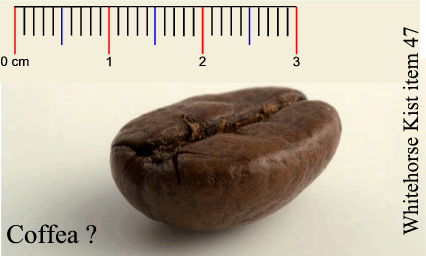
During August 2011 it was announced that excavation had begun on a prehistoric kistvaen that had been discovered on Whitehorse Hill 10 years ago. Following on from that excavation it was announced in February 2013 that preliminary findings regarding the grave goods in the kist were, “the national park’s most important archaeological finds ever,” and “the first organic remains found on Dartmoor.” Amongst the remarkable finds of the Whitehorse Hill Kist was a woven bag which contained an assemblage of beads along with two wooden ear studs. As the conservators began continued their work it became evident that two of the beads were completely different to the rest. The first one was unquestionably made from amber which in itself provided evidence that there was some form of trade/exchange taking place on Dartmoor. The second bead however appeared to be fashioned from a much softer material and took a different form. As the layers of encrusted peat were painstakingly removed from the bead an amazing realisation suggested that it consisted of an unknown organic material. By the very fact that the bead was part of the grave goods assemblage indicated that it held some importance to its owner.
Following investigations failed to identify the mysterious material so it was decided to subject a sample to DNA testing in the hope that a positive conclusion could be arrived at. When the results came back the conservation team were astounded at what was seemingly was an impossible identification. The decision was taken to submit another sample for re-testing as there was a strong possibility that the initial sample had been contaminated. This time extra care was taken to ensure that the second sample was undoubtedly uncontaminated. When the second results were obtained they merely confirmed the unbelievable conclusion as the first test. The bead was in fact not a bead but a previously unknown distant relative of the plant genus Coffea which today includes the modern varieties of Coffea canephora and C. aribica commonly referred to as coffee beans.

The enigmatic Coffea bean
All documented records of coffee occur no earlier than the 17th century although there is one doubtful suggestion of it being used in the 9th century. Therefore this fantastic discovery has re-written both the Dartmoor and worldwide archaeological records. There can be no suggestion that the plant was grown on the moor but it clearly demonstrates that the trading/exchange range of these early inhabitants spanned not only large national distances but crossed vast continents.
Although it seems unperceivable that Bronze Age man may well have enjoyed a cup of coffee with his oat cakes there can be no question that the beans were regarded as prodigious possessions and highly regarded enough to be buried with their dead.
The conservation team have warned that one bean does not a cup of coffee make, it could well be that this will be the only one found amongst the grave goods. However, they do want to emphasise the importance of this discovery and are tentatively hailing it as possibly the most important archaeological find of the century.
For the official copyrighted report of this discovery please follow the link – HERE
 Legendary Dartmoor The many aspects past and present of Dartmoor
Legendary Dartmoor The many aspects past and present of Dartmoor
